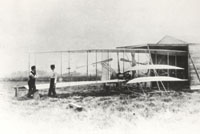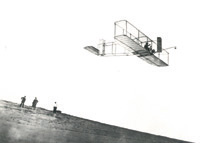|
|
 |
| SW Aviator Magazine is available in print free at FBOs and aviation-related businesses throughout the Southwest or by subscription. |

|
 |

|
 |
 |
 |
|
The web's most comprehensive database of Southwest area aviation events.
|

|
 |

|
 |
|
Featured Site:
|
|
|
 |
|
A continuosly changing collection of links to our favorite aviation related web sites.
|

|
 |

|
 |

|
 |
Search by:

|
|
|
Or enter a keword:

|
|
|
Post a FREE Classified Ad 
|
 |
|

|
A Tribute to Perseverance
|
|
The Beginning of Flight
|
 By Jay Wischkaemper By Jay Wischkaemper
You have to wonder why they bothered. They didn’t need the money. The bicycle shop was doing well, as it should have been. Bicycles were one of the premier modes of transportation in 1900. Automobiles were in their infancy. Compared to the horse and buggy, a bicycle was modern technology. And flying? Do you really think man can fly? Man wasn’t meant to fly! Leave flying to the birds. Come back down to reality. Man will never fly.
Or so went the traditional wisdom of the day. But a small band of determined inventors dreamed of the day that man would fly, and were determined to make that dream a reality. Among them were two brothers: Orville and Wilbur Wright.
In many ways, their quest was laughable. Little was understood about aerodynamics. Birds flew, and kites flew, but precisely what made either happen was still largely a mystery. The lack of knowledge didn’t deter the Wrights. They had a dream. And somehow, although they didn’t initially know how, they thought it could be done. They did what any inventor does. They took what was known, limited though it was, and determined to learn whatever was needed to make the dream a reality.
The quest began in the winter of 1900, when the pair went to Kitty Hawk, NC to test a glider they had built. The wings were 17 1/2 feet wide and the chord was 5 feet. The glider flew, but the brothers learned it would not produce enough lift to support the weight of a man and an engine. They returned to Ohio encouraged, and determined to try again.
In the winter of 1901, they were back. Again, they learned that their design lacked enough lift. They were basing their calculations on measurements of lift made by Otto Lilienthal, and while those measurements were all that were available, they began to doubt their accuracy. Leaving Kitty Hawk in 1901, the brothers were discouraged, but not deterred. Before their return in 1902, they developed a wind tunnel, with which they determined that the previous calculations of the coefficient of lift were too high. With their new, more accurate measurements of lift and drag, they were able to return to Kitty Hawk and successfully fly a glider that would provide adequate lift.
They now had an airframe design. The next problem was a propulsion system. Over the next year, Charles Taylor developed a 12 horsepower engine for the aircraft, and the Wrights were able to figure out the aerodynamics of propellers, setting the stage for the first manned flight.
|
|
|
On December 14, 1903, with Wilbur at the controls, the Wright flyer made its first run. It flew, but not being acclimated to the technique of flight, Wilbur basically stalled the craft, causing damage to the left wing. Two days later, this time with Orville at the controls, the first successful flight was made. 12 seconds. 120 feet. It wasn’t much, but it was a start.
We now find ourselves 100 years removed from that historic moment, and technologically a world away. If the Wright brothers were to be resurrected today to see the metamorphosis of their invention, they would be dumbfounded. From that first 120 foot, 12 second flight, we have progressed to flights of over 7,000 miles in aircraft carrying 400 people in pressurized comfort 8 miles above the oceans they are crossing, eating hot meals and watching a movie. Navigation, which the Wright’s hardly even needed to consider, is provided by satellites orbiting thousand of miles above the earth, with a navigational accuracy measured in inches. Not in their wildest dreams could these men have foreseen the progress that would be made in powered flight over the last 100 years. But before we pat ourselves in the back about how far we’ve come, perhaps we need to be humbled by the thought that like them, we have no concept of what powered flight will look like 100 years from now. Will planes be powered by atomic energy? Will an anti-gravity device have been perfected? Who knows? But today’s cutting edge technology will probably appear primitive by the standards of that day.
What kind of world would it be had those visionaries not pursued their passion? It would be a much larger world, without the ability to travel thousands of miles in a matter of a few hours. Travel that takes hours would be measured in days. Many of the efficiencies of time that we take for granted are there only because of aviation. One need only look at the impact on our society during the few days when there was no aviation after 9-11 to see its value and importance to the way we live. And yet there is another side of aviation that some might feel more comfortable without. While wings have transformed the way we travel, the wings of war have transformed the way we fight. As is the case with most things, aviation can be used for good or for evil. It all depends on the individual, and on your perspective. To us, a laser-guided bomb falling on an enemy position is good. To the enemy, it’s quite another matter. An airliner carrying people across the nation is good. When that airplane is flown into a building, it is anything but good.
What about the future? What does it hold? I’ve been flying for over 30 years, and as I think about those early trainers I flew that were considered well equipped if they had an ADF in addition to the normal Mark 12, I marvel at the capability of the electronics that now reside in my plane. The engine and airframe may be 30 years old, but the gadgetry that I face as I wing my way toward my destination makes it appear much more modern. The sectionals on which I used to draw lines and look for landmarks have been replaced by the moving map display, and flight planning consists of checking the weather and looking up the identifier of where I want to go. Most of that technological growth has occurred in the last 15 years. It seems hard to imagine what else could be on the horizon, and yet on a regular basis, someone reveals something more innovative than what we thought was the latest and greatest only a few years ago. It’s an exciting time.
 As marvelous as the invention of the airplane was, it has contributed one thing to society that goes far beyond the process and technique of flight. It has taught us the lesson of perseverance. It has taught us that when people laugh at you and think you’re crazy, it may not be you that has the problem. It has taught us that just because the world may think something is impossible, the world may be wrong. Two simple bicycle mechanics with a dream changed the world because they refused to listen to those who said it couldn’t be done. There will always be two groups of people in the world: those who point out the possible, and those who set out to achieve it. Fortunately for us, two men named Orville and Wilbur Wright refused to listen to reality, and we now enjoy the fruits of their reality. It is only fitting that we pay special tribute to these men on the anniversary of that great achievement. As marvelous as the invention of the airplane was, it has contributed one thing to society that goes far beyond the process and technique of flight. It has taught us the lesson of perseverance. It has taught us that when people laugh at you and think you’re crazy, it may not be you that has the problem. It has taught us that just because the world may think something is impossible, the world may be wrong. Two simple bicycle mechanics with a dream changed the world because they refused to listen to those who said it couldn’t be done. There will always be two groups of people in the world: those who point out the possible, and those who set out to achieve it. Fortunately for us, two men named Orville and Wilbur Wright refused to listen to reality, and we now enjoy the fruits of their reality. It is only fitting that we pay special tribute to these men on the anniversary of that great achievement.
Texas native Jay Wischkaemper is a successful MassMutual life insurance agent based in Lubbock, Texas. He is a long-time partner in a Bellanca Super Viking, which he uses for both business and pleasure. Jay is a Texas Tech alumni, where he earned a degree in public address and group communication. |
Click here to return to the beginning of this article.  |
|